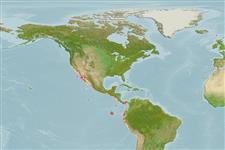Common names from other countries
>
Syngnathiformes (Pipefishes and seahorses) >
Syngnathidae (Pipefishes and seahorses) > Syngnathinae
Etymology: Hippocampus: Greek, ippos = horse + Greek,kampe = curvature (Ref. 45335).
More on author: Girard.
Environment: milieu / climate zone / depth range / distribution range
Ecologie
marien rifbewoner; standvastig; diepte 0 - 60 m (Ref. 30915), usually 3 - 18 m (Ref. 5227). Subtropical; 37°N - 22°S, 123°W - 70°W
Eastern Pacific: confirmed records from San Diego in California, USA to Peru including the Galapagos Islands.
Reported from the San Francisco Bay by Alexander Agassiz (Ron Fritzsche, pers.comm. 08/09).
Lengte bij maturiteit / Grootte / Gewicht / Leeftijd
Maturity: Lm 5.4 range ? - ? cm
Max length : 30.0 cm TL mannelijk / geslacht onbekend; (Ref. 2850)
Korte beschrijving
Determinatiesleutels | Morfologie | Morfometrie
Dorsale stekels (totaal) : 0; Dorsale zachte stralen (totaal) : 18 - 21.
Nocturnal. Occur in offshore waters, mostly captured by dredging at 10 m or deeper. Occasionally caught at surface. Are often camouflaged within the branches of gorgonians and black coral trees where they are seen to curl their tail around the branches (Ref. 5227). Have been found in the stomachs of Pacific yellowfin tuna and bluefin tuna (Ref. 30915). Ovoviviparous (Ref. 205). The male carries the eggs in a brood pouch which is found under the tail (Ref. 205).
Male carries the eggs in a brood pouch (Ref. 205). Gestation period is 14-15 days depending on temperature (Ref. 30915).
Lourie, S.A., R.A. Pollom and S.J. Foster, 2016. A global revision of the seahorses Hippocampus Rafinesque 1810 (Actinopterygii: Syngnathiformes): taxonomy and biogeography with recommendations for further research. Zootaxa 4146(1):1-66. (Ref. 115213)
Status op de Rode Lijst van het IUCN (Ref. 130435)
Gevaar voor de mens
Harmless
Gebruik door de mens
Visserij: commercieel; Aquarium: Commercieel
Tools
Speciale rapporten
Download XML
Internetbronnen
Estimates based on models
Preferred temperature (Ref.
115969): 19.1 - 28.5, mean 24.3 (based on 131 cells).
Fylogenetische diversiteitsindex (Ref.
82804): PD
50 = 0.5000 [Uniqueness, from 0.5 = low to 2.0 = high].
Bayesian length-weight: a=0.00447 (0.00177 - 0.01127), b=3.00 (2.78 - 3.22), in cm Total Length, based on LWR estimates for this (Sub)family-body shape (Ref.
93245).
Trofisch niveau (Ref.
69278): 3.3 ±0.38 se; based on food items.
Weerstandsvermogen (Ref.
120179): Hoog, minimale populatieverdubbelingstijd minder dan 15 maanden (tm=0.3-0.4).
Fishing Vulnerability (Ref.
59153): Low vulnerability (20 of 100).
